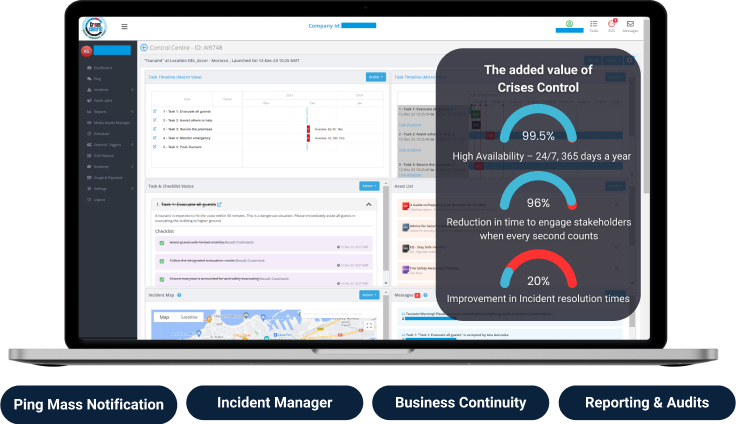Written by Shalen Sehgal | CEO
Imagine a scenario – a fire breaks out in your office building, and panic starts to set in. In this critical moment, how will you effectively communicate with your employees and ensure their safety? This is where a robust emergency mass notification system becomes a hero.
The Benefits of Emergency Mass Notification Systems

The Advantages of an Emergency Mass Notification System
Traditional emergency notification methods like sirens or intercoms have limitations. They lack precision, may not reach everyone, and can exacerbate panic in high-stress situations. An emergency mass notification system (EMNS) offers a more comprehensive and effective solution.
- Speed is King: EMNs deliver critical alerts instantly through multiple channels – SMS, voice calls, email, desktop pop-up notifications, and even digital signage. This ensures everyone receives the message simultaneously, regardless of location or device.
- Targeted Communication: Gone are the days of blanket notifications. EMNS allows for targeted messaging. Geo-targeting capabilities can deliver alerts to specific areas impacted by the crisis, while role-based notifications ensure relevant information reaches the right personnel.
- Two-Way Communication: EMNs aren’t just one-way streets. They can facilitate two-way communication, allowing employees to acknowledge receipt of messages, report their status, or ask questions. This vital feedback loop improves situational awareness and streamlines response efforts.
- Increased Transparency: Timely and accurate information is crucial during emergencies. EMNs can be integrated with business continuity software, allowing for the dissemination of pre-recorded messages, safety protocols, and evacuation plans. This transparency fosters trust and minimises confusion.
Emergency Mass Notification Systems: Not Just for Emergencies
The benefits of emergency mass notification systems extend far beyond emergency situations. They can be a valuable tool for:
- Planned Outages: Use EMNs to notify staff about scheduled maintenance or power outages, minimising disruptions and ensuring a smooth workflow.
- Severe Weather Alerts: Keep employees informed about approaching storms, flooding, or other weather emergencies, allowing them to take necessary precautions.
- Active Shooter Situations: EMNs can be a lifesaver in active shooter situations by providing real-time lockdown instructions and evacuation routes.
- Public Health Emergencies: Rapidly disseminate critical information during pandemics or outbreaks, promoting safety and public awareness.
Choosing the Right Emergency Mass Notification System for Your Business
The ideal emergency mass notification system should be tailored to your organisation’s specific needs. Here are some key factors to consider:
- Scalability: Choose a system that can grow with your business, accommodating future expansion or changes in personnel.
- Integration Capabilities: Ensure seamless integration with existing security systems, human resource databases, and business continuity software.
- Ease of Use: An intuitive and user-friendly interface is crucial for administrators and employees, especially during high-pressure situations.
- Multi-Channel Communication: Look for a system that offers a variety of communication channels to reach all employees, irrespective of their preferred method.
- Reporting and Analytics: Robust reporting features enable you to analyse the effectiveness of your notifications and identify areas for improvement.
Beyond the Basics: Advanced EMN Strategies
Here are some advanced strategies to maximise your emergency mass notification system’s effectiveness:
- Regular Testing and Training: Conducting drills and simulations helps identify system vulnerabilities and ensures employees are comfortable using the technology.
- Develop Clear Communication Protocols: Establish clear guidelines for message content, approval processes, and escalation procedures.
- Maintain an Up-to-Date Contact Database: Regularly update employee contact information to ensure everyone receives critical notifications.
- Integrate with Social Media: Utilise social media platforms to disseminate alerts to the broader community during large-scale emergencies.
By implementing these strategies, you can transform your emergency mass notification system from a valuable tool into a cornerstone of your crisis management plan.
Remember, in a crisis, every second counts. An emergency mass notification system empowers you to take control of the situation, ensuring the safety of your employees, minimising disruptions, and safeguarding your reputation. But what sets Crises Control apart when it comes to emergency mass notification?
Crises Control: Your Trusted Partner in Emergency Preparedness
At Crises Control, we go beyond simply providing an emergency mass notification system. We offer a comprehensive suite of solutions designed to bolster your organisation’s crisis preparedness and response capabilities. Here’s how we stand out:
- Customised Implementation: Our team of experts works closely with you to understand your unique needs and risk profile. We then tailor the EMN system configuration and develop customised communication protocols to ensure optimal effectiveness.
- Seamless Integration: We ensure seamless integration of your EMN system with existing infrastructure, including security systems, access control, and business continuity software. This eliminates data silos and fosters a unified approach to crisis management.
- Ongoing Support and Training: We don’t just install the system and walk away. Our team provides ongoing support and training to ensure your staff is comfortable using the technology and can leverage its full potential during emergencies.
- Compliance Expertise: We stay abreast of evolving regulations and compliance requirements related to emergency notification. This ensures your organisation remains compliant and minimises legal liabilities.
Going Beyond Emergency Notification: Building a Culture of Preparedness
A robust emergency mass notification system is a critical piece of the puzzle, but it’s just one aspect of comprehensive crisis preparedness. Crises Control offers a holistic approach that goes beyond notification:
- Crisis Management Planning: We collaborate with your team to develop a comprehensive crisis management plan, outlining roles, responsibilities, communication protocols, and response procedures for various crisis scenarios.
- Business Continuity Planning: Our experts assist you in developing a business continuity plan to ensure critical operations can be restored quickly after a disruptive event. This minimises downtime and safeguards your bottom line.
- Tabletop Exercises: Regularly conducting tabletop exercises allows you to test your crisis response plans in a simulated environment, identify vulnerabilities, and refine your approach.
By partnering with Crises Control, you gain access to a wealth of expertise and resources to create a culture of preparedness within your organisation. This proactive approach minimises the impact of crises and fosters a more resilient business environment.
Investing in Peace of Mind
Crises are inevitable, but their impact doesn’t have to be. By implementing a robust emergency mass notification system and establishing a comprehensive crisis management plan, you empower your organisation to weather any storm.
Contact Crises Control today to schedule a free consultation and learn how we can help you safeguard your people, operations, and reputation.
Request a FREE Demo
Interested in our Award-Winning Emergency Mass Notification Software?
FAQs
1. What are the advantages of an emergency mass notification system over traditional emergency notification methods?
Traditional methods like sirens or intercoms lack precision and can cause panic. EMNs offer several advantages:
Speed and Targeted Communication: They deliver instant alerts through multiple channels to specific individuals or areas.
Two-Way Communication: They enable employees to acknowledge receipt or ask questions, improving situational awareness.
Increased Transparency: Integration with business continuity software allows for sharing pre-recorded messages and safety protocols.
2. Can emergency mass notification systems (EMNS) be used for non-emergency situations?
Absolutely! EMNS are valuable for planned outages, severe weather alerts, and public health emergencies. They can also be used for disseminating important information or company announcements.
3. What factors should I consider when choosing an emergency mass notification system?
Here are some key considerations:
Scalability: Choose a system that can grow with your organisation.
Integration Capabilities: Ensure seamless integration with existing security systems and business continuity software.
Ease of Use: An intuitive interface is crucial for administrators and employees under pressure.
Multi-Channel Communication: Look for a system with various channels to reach all employees.
Reporting and Analytics: Robust reporting helps you analyse notification effectiveness and identify areas for improvement.
4. What makes Crises Control different from other emergency mass notification providers?
Crises Control goes beyond just the system. We offer:
Customised Implementation: We tailor the system and communication protocols to your specific needs.
Seamless Integration: We ensure your EMN integrates with existing infrastructure.
Ongoing Support and Training: We provide ongoing support and training for your staff.
Compliance Expertise: We keep you updated on evolving regulations related to emergency notification.
Proactive Threat Identification: Our systems can integrate with threat intelligence feeds to identify potential risks and send early warnings.
5. What are the benefits of a comprehensive crisis management plan beyond just having an emergency mass notification (EMN) system?
An EMN is crucial, but a complete plan offers more:
Crisis Management Planning: We help you develop a plan outlining roles, responsibilities, and procedures for various emergencies.
Business Continuity Planning: Our experts assist you in planning how to restore critical operations after a disruptive event.
Incident Response Training: We provide training to equip your staff with the knowledge and skills to react effectively during emergencies.
Tabletop Exercises: We conduct simulations to test your plan, identify vulnerabilities, and refine your approach.
By creating a culture of preparedness, you minimise the impact of crises and ensure a more resilient organisation.
